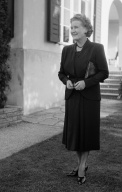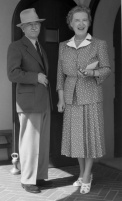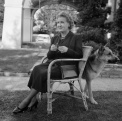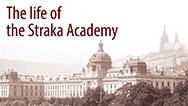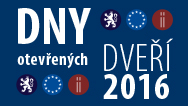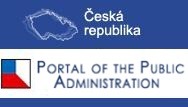Important personalities
13. 8. 2010
Mrs. Hana - on the occasion of 125th birth anniversary of Hana Benešová
When Karel Čapek published these sentences, on 19 December 1935, one day after election of Edvard Beneš a president, on pages of the daily Lidové noviny, he could not expected what a life's pilgrimage was still ahead of that new First Lady.
Anna Vlčková was born on 16 July 1885 in Domaslavice u Oseku in a family of railway sentry and a dressmaker. When she was fourteen, a well-off aunt decided to invest her money into education and upbringing of her niece. Anna graduated at a house school and lived with her aunt in Prague-Vinohrady in a family of the police president Václav Olič. She established inseparable friendship with his daughter Aťa (her name was also Anna). In 1905 both girls left to Sorbonne University to continue their education.
During her Paris stay, Anna Vlčková met Edvard Beneš, a university student and correspondent of Czech left-wing journals. Poor young man, rather aloof and strict, was not able to flirt very much. After an unsuccessful relationship with a girl called Anna in his native village Kožlany, he was not interested in an immediate establishment of relationship with a new acquaintance. A peculiar friendship was established between that strong-minded intellectual and the two girls. Beneš became their teacher and guide to Paris; girls became to care for him, they taught him how to dress and behave in society. It was Anna Vlčková who paid more attention to him; first, he won her admiration and then even love. They got engaged on 16 May 106 in Paris and it was the famous Luxembourg garden which served as a scene of the ceremony. The young lady, at the request of the young man, changed her first name from Anna to Hana. Their marriage followed three years later on 6 November in the Saint Ludmila church in Prague-Vinohrady.
The World War One
In the following years, Edvard Beneš was finishing his studies, he taught at a business collage and starting from 1913 he became a lecturer at the Charles University and later at the Technical University in Prague. The young lady not only ran her household but she also copied lectures for students, she arranged notes and press clippings and she was particular about his appearance and cared for his relaxation.
After the outbreak of the World War I, Beneš sold his two apartment houses and part of his money, including wife's dowry, donated to the anti-Austrian revolt. After the emigration of T.G. Masaryk, he shortly headed an anti-Austrian group "Maffie", but as early as on September 1915 he went to exile. He offered his wife divorce to safe her but she refused. Together with her friends, Hana Benešová sheltered Masaryk's documents and was also engaged in other information activities. In November 1915 she was arrested and kept in prison until March 1916. Then she was released because of health reasons and at the end of 1916 she was imprisoned again for four months. She was very oppressed by musty and dirty cells; under the pressure of brutal investigators, she disclosed certain information and her testimony for some time paralysed revolt activities. She spent eleven months in prisons in Prague and Vienna.
Establishment of the Czechoslovak Republic
The establishment of the Czechoslovak Republic meant a great landmark for Hana Benešová. Beneš was holding the office of the Minister of Foreign Affairs and was spending a lot of time out of the territory of the new-born state. Hana Benešová accompanied her husband at social events and without any problems transformed herself into the role of the wife of an important European diplomat. Husband and wife spent most of the time together and even during a short separation they kept up a correspondence. From those letters full of genuine tenderness, it is possible to read that their marriage tended to be childless. Their correspondence informs us about other plans and desires of the married couple and also about the construction of the summer house in Sezimovo Ústí which became their common pleasure.
Wife of the President of the Republic
Hana Benešová became the wife of the president officially as late as on18 December 1935 when her spouse was elected a head of the state. For three years, Edvard Beneš was trying to protect Czechoslovakia against the Nazi Germany. He regarded the Munich Pact and lapse of western democracies as his personal defeat and on 5 October 1938 he abdicated and soon after it he left, together with his wife, to England. After the initial rejections of British and French politicians, Edvard Beneš started new struggle for the restoration of the Czechoslovak Republic. Hana Benešová became a Chairperson of the Red Cross, she established Czech nursery in London, and helped soldiers to provide medicines, soap, clothes and money. Through the BBC she talked to her enslaved country. Together with Beneš, she became a part of the London elite and was invited into the Buckingham Palace. She accompanied his spouse during his visits of army troops and during official visits of Washington and Moscow. After an imposing welcome which Prague inhabitants prepared for Edvard Beneš on 16 May 1945, Hana Benešová was engaged again in health and social issues. She received members of the Red Cross, numerous deputations asked her for taking auspices over various events; together with Jan Masaryk, she became a godmother of the fist newborn child of Lidice (village burnt by Nazis). As a reward for her activities she received not only money but she was also given rather a peculiar gift 500 quintals of coal which miners of her native region collected from their allowances and which they donated for social purposes. Hana Benešová distributed all gifts to nurseries, kindergartens and social facilities.
After the year 1948
The period of postwar years was finished in February 1948 in such a way that the tragedy of Edvard Beneš was completed. Similarly as ten years ago, the strongest support was provided by his wife. He survived the fall of democracy in Czechoslovakia only by several months; he died on 3 September 1948 in the villa in Sezimovo Ústí in the arms of Hana Benešová.
Hana Benešová survived her spouse by the entire quarter of a century. She lived alternately in Prague and in Sezimovo Ústí under a close control of the State Police. She never coped with the death of her beloved husband but when her nephew and his wife gave birth to a daughter, Hana Benešová found again enjoyment of life she had reason to live for somebody. Mrs. Hana, as people privately called her, was surrounded by love of friends and anonymous people who sent her flowers, books and small gifts. She very attentively followed radio and television broadcasting; she read newspapers, visited concerts and art exhibitions. Wherever she came she was an object of interest and silent respect.
Hana Benešová died on 2 December 1974 in her apartment in Prague at Loretánské náměstí in the age of eighty-nine. The urn with her ashes was in the following year placed into the tomb of Edvard Beneš in the garden of the villa in Sezimovo Ústí.
At present the villa in Sezimovo Ústí serves not only for the sake of prestige of the Prime Minister but it is also a worthy memorial to Hana and Edvard Beneš which is regularly opened to the public.
